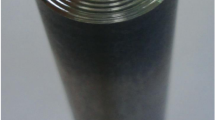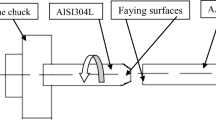Abstract
Conventionally in friction welding, the rubbing or faying ends of the base material rods are square turned. For the case of dissimilar friction welding, this design is not optimum because of differential flow behavior of the materials. When, only one of the materials deforms preferentially, the actions of cleaning and expulsion of oxides and impurities from the interface would not be as effective. This will adversely affect the joint properties. In this study, alternate designs of faying surfaces such as providing taper (external and internal) and smoother surfaces are compared with the square cut design. The aim was to study how the faying surface conditions of the stronger material affect the flow behavior of the weaker material. By affecting better flow behavior, the intention was to expel intermetallics and other impurities from the interface, and thereby improve joint properties. Friction welding of stainless steel with aluminum alloy (aluminum-magnesium-silicon) was studied. The joints were evaluated for strength and it is found that the external tapered system has the best strength. Different characterization techniques such as optical microscopy, scanning electron microscopy, x-ray diffraction were carried out to observe different phases, microstructure zones, etc., at the interface. Finally, possible reasons for the better strength of tapered system were discussed.










Similar content being viewed by others
References
B.S. Yilbas, A.Z. Sahin, N. Kahraman, and A.Z. Al-Garni, Friction Welding of St-Al and Al-Cu Materials, J. Mater. Process. Technol., 1995, 49(3–4), p 431–443
K.G.K. Murti and S. Sundaresan, Parameter Optimization in Friction Welding Dissimilar Materials, Met. Constr., 1983, 15(6), p 331–335
A. Changqing and J. Zangpeng, The Evolution of Microstructure and Diffusion Paths in the Titanium-Steel Explosion Weld Interface During Heat Treatment, J. Less Common Met., 1990, 161, p 315–322
B. Qin, G.M. Sheng, J.W. Huang, B. Zhou, S.Y. Qiu, and C. Li, Phase Transformation Diffusion Bonding of Titanium Alloy with Stainless Steel, Mater. Charact., 2006, 56(1), p 32–38
S. Fukumoto, H. Tsubakino, K. Okita, M. Aritoshi, and T. Tomita, Amorphization by Friction Welding Between 5052 Aluminum Alloy and 304 Stainless Steel, Scr Mater, 2000, 42(8), p 807–812
S. Fukumoto, H. Tsubakino, K. Okita, M. Aritoshi, and T. Tomita, Friction Welding Process of 5052 Aluminium Alloy to 304 Stainless Steel, Mater. Sci. Technol., 1999, 15(9), p 1080–1086
M. Yilmaz, M. Col, and M. Acet, Interface Properties of Aluminum/Steel Friction-Welded Components, Materials Characterization, 2002, 49(5), p 421–429
A. Fuji, K. Ameyama, and T.H. North, Improved Mechanical Properties in Dissimilar Ti-AlSl 304L Joints, J. Mater. Sci., 1996, 31(3), p 819–827
R.A. Bell, J.C. Lippold, and D.R. Adolphson, An Evaluation of Copper-Stainless Steel Inertia Friction Welds, Weld. J., 1984, 63(11), p 325s–332s
H.C. Dey, M. Ashfaq, A.K. Bhaduri, and K. Prasad Rao, Joining of Titanium to 304L Stainless Steel by Friction Welding, J. Mater. Process. Technol., 2009, 209, p 5862–5870
S.D. Meshram, T. Mohandas, and G. Madhusudhan Reddy, Friction Welding of Dissimilar Pure Metals, J. Mater. Process. Technol., 2007, 184(1–3), p 330–337
K. Ogawa, G. Kawai, K. Sakurai, H. Yamaguchi, and Y. Takashima, Evaluation of Friction Welded Joint Performance by Recognition Of Burr Shape, SICE 95, 1995, 1163–1166
W.-B. Lee and S.-B. Jung, Effect of Microstructure on Mechanical Properties of Friction-Welded Joints Between Ti and AISI, 321 Stainless Steel, Mater. Trans., 2004, 45(9), p 2805–2811
A. Kobayashi, M. Machida, S. Sukaya, and M. Suzuki, Friction Welding Characteristics of Al-Mg Aluminum Alloy (a5056) and Carbon Steel (s45c), JSME Int. J., 2003, 46, p 452–459
R.S. Mishra and Z.Y. Ma, Friction Stir Welding and Processing, Mater. Sci. Eng. R, 2005, 50(1–2), p 1–78
A. Fuji, T.H. North, K. Ameyama, and M. Futamata, Improving Tensile Strength and Bend Ductility of Titanium/AISI, 304L Stainless Steel Friction Welds, Mater. Sci. Technol., 1992, 8(3), p 219–235
A.Z. Sahin, B.S. Yibas, M. Ahmed, and J. Nickel, Analysis of the Friction Welding Process in Relation to the Welding of Copper and Steel Bars, J. Mater. Process. Technol., 1998, 82, p 127–136
J. Luo, Y.H. Ye, J.J. Xu, J.Y. Luo, S.M. Chen, X.C. Wang, and K.W. Liu, A New Mixed-Integrated Approach to Control Welded Flashes Forming Process of Damping-Tube-Gland in Continuous Drive Friction Welding, Mater. Des., 2009, 30(2), p 353–358
Welding Handbook, Vol 1, 9th ed., American Welding Society, Miami, 2001
Author information
Authors and Affiliations
Corresponding author
Rights and permissions
About this article
Cite this article
Ashfaq, M., Sajja, N., Khalid Rafi, H. et al. Improving Strength of Stainless Steel/Aluminum Alloy Friction Welds by Modifying Faying Surface Design. J. of Materi Eng and Perform 22, 376–383 (2013). https://doi.org/10.1007/s11665-012-0278-0
Received:
Revised:
Published:
Issue Date:
DOI: https://doi.org/10.1007/s11665-012-0278-0




